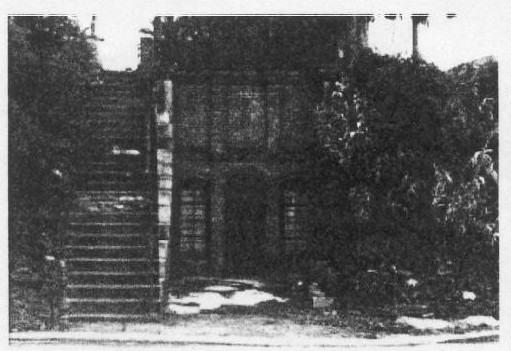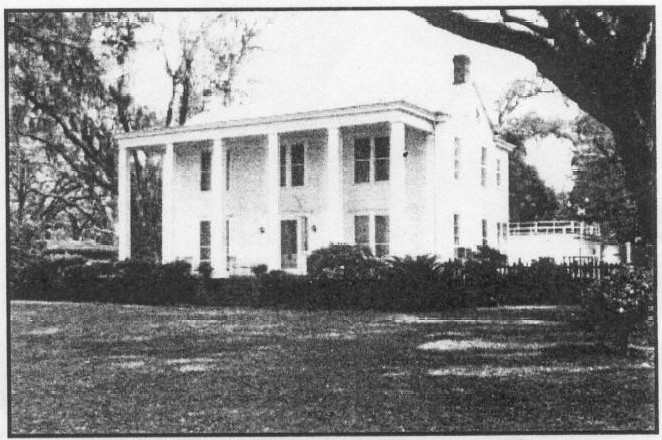
Civil War Comes to Arlington
In 1858 Thomas F. Perley constructed a residence on a large parcel of land along the river at Empire Point. A decade later he sold the property, called "Perley Place," to a prominent Jacksonville banker. The house later burned, but a wine cellar, dug into the bluff at the river and connected to the main house by a tunnel, survives. It is one of Jacksonville's rare ante-bellum structures.

The Federal occupation of Jacksonville depended
upon safe navigation of the St. Johns River by Union naval forces. In September,
1862, a squadron of Federal gunboats began an assault against a strong
Confederate position atop the St. Johns Bluff, which commanded the water
below. Landing operations began October 1 when a force of 1,500 Federal
troops landed on the south bank of the river below the bluffs and advanced
upon the Confederates atop the bluff. The outmanned Confederates fled and
soon the Stars and Stripes rose over the bluff. The engagement at St. Johns
Bluff permitted Union forces to control the river and East Florida for
the remainder of the war.
Civil War and Reconstruction (1861-1877)
Jacksonville was the site of significant activity
during the Civil War. Among the first of the important Southern ports surrendered
to the Union, it was occupied periodically throughout the war by Federal
troops. The first Federal occupation of Jacksonville occurred on March
12, 1862. At that time, Confederate troops stationed there retired to the
vicinity of Baldwin. On April 8 the Federals moved on, leaving many citizens
who had expressed oaths of loyalty to the Union undefended against their
returning Confederate neighbors. A second occupation lasted four days in
October, 1862, and a third for nineteen days in March, 1863. The third
occupation brought the uncommon sight of black troops in Jacksonville.
The
fourth Federal occupation began on February 7, 1864, when some 7.000 Union
troops were assembled for an assault on the Florida countryside. Repulsed
by Confederate defenders at Olustee, near Lake City, the Federal troops
retreated to Jacksonville, where they remained for the duration of the
war.
Though a slave owner himself, Sammis ardently
supported the Union cause. In 1860 he quit the lumber business and moved
to Baldwin, Florida, about twenty-five miles west of downtown Jacksonville.
He retained the property at Arlington Bluff, however. In the Spring of
1862 Sammis returned to Jacksonville to help set up a Florida government
opposed to secession. When the Confederates re-occupied the city he fled
to New York. There, in the summer of 1862, at a meeting of Florida Unionists
he met Lyman Stickney, a Vermont native, who had tried before the war to
promote new agricultural settlements in Florida. With Stickney's help,
Sammis secured an appointment to the Direct Tax Commission, created to
carry out the seizure and sale of lands in Florida held by rebeIs who had
failed to pay their taxes. Another member of the Commission was Harrison
Reed, a Wisconsin newspaper editor who after the war became the Reconstruction
governor of Florida. Sammis resigned from the Direct Tax Commission in
1863 after a dispute with Stickney and in February, 1864, upon the reoccupation
of Jacksonville by Union troops, returned to the city. He arrived with
a ship load of goods and set up business with Thomas S. Ellis, a Unionist
merchant in St. Augustine before the war. Two sons of Sammis, Edmund and
Egbert, worked with him in the store.
John Sammis apparently retired from Florida
politics after the war. In 1868 he became involved in an unsuccessful railroad
venture and two years later moved to Mandarin. He lived yet another fourteen
years. Sammis was buried in the small cemetery at Clifton, close to his
Arlington home. His property there was sold in 1873 to a church colony
from New Jersey, which used it as a resort for its members. Named the Ocean
Grove Association, it subdivided the property into residential lots. The
Sammis house, called the Florida Winter Home, served as a hotel for tourists
and prospective buyers of land in the vicinity. At the time a large two-story
wing was added to the building. A brochure issued in 1873 reveals the configuration
of the house before the addition of a columned portico. The church group
soon folded. The property was sold to William Matthews, a Philadelphia
businessman.
Post-Reconstruction to the Turn-of-the-Century (1878-1900)
The pace of development in northeast Florida
quickened during prosperous years that followed the war and its traumatic
aftermath, known as the Reconstruction Era. The building boom was fueled
by an influx of new settlers and tourists, drawn to Florida in growing
numbers. Its rail and steamship connections made Jacksonville a popular
tourist destination. A steamboat trip up the St. Johns and Ocklawaha rivers,
reaching almost the center of the Florida peninsula, became a favorite
excursion for Americans wealthy enough to afford it. The trip began at
Jacksonville, where by 1880 some forty hotels and numerous boarding houses
had been constructed to accommodate the estimated annual 75,000 visitors.
The most significant building was the St. James Hotel. which dominated
Jacksonville's skyline until its destruction by fire in 1901.
Real estate companies catered to the visitors,
encouraging them to make northeast Florida their second or "winter" home.
A growing number of new residents took up lands on the east bank of the
St. Johns River, where bluffs rise sharply above the water, offering a
high, wooded, and picturesque location. Robert Bruce Van Valkenburg, a
former congressman from New York, Union officer, and minister to Japan
from 1866 to 1869, purchased an eighteen-acre site on what is now Empire
Point in 1870. He ostensibly retired to Florida to recover his health,
but almost at once plunged into local political life, winning an appointment
as Associate Justice of the Florida Supreme Court. Denounced by the Tallahassee
Weekly
Floridian as a "carpet-bag" jurist, he nevertheless served on the bench
from 1874 until his death in 1884. Van Valkenburg's house on Hazzard's
Bluff. now Empire Point, remains standing at 1231 Glengarry Road.
In the same vicinity, another former Union
officer, Gelleral Alexander S. Diven, a New York lawyer and legislator,
purchased the site on Hazzard's Bluff where in the 1850s John Clark had
operated his saw mill. One of many travel accounts of Florida, published
in 1885, described the residence that Diven built there as follows:

The Diven-Dunkee House, 4749 River Point Road, circa 1877.
The first place situated on the peninsula formed by the confluence of the St. Johns River and Arlington Creek is the property of General A. S. Diven, one of the most beautiful places in St. Nicholas. It contains 34 acres, and the mansion, a fine large house surrounded by a broad piazza, is distant from the landing some 200 yards.
A neighbor of Diven's was Major Joseph H. Durkee, another former Union officer. His son, Dr. Jay H. Durkee, purchased the Diven residence from General Diven's son, George, in 1909. It was the Durkee heirs who in the 1950s subdivided the surrounding ninety acres into the Empire Point subdivision. Until that time, the Diven House and Marabanong (see next page) were among the very few residences perched upon the bluff, which from a vantage point on the south bank of the Arlington River overlooks the confluence of the Arlington and St. Johns rivers.
continued on jackvil7.htm ...............

